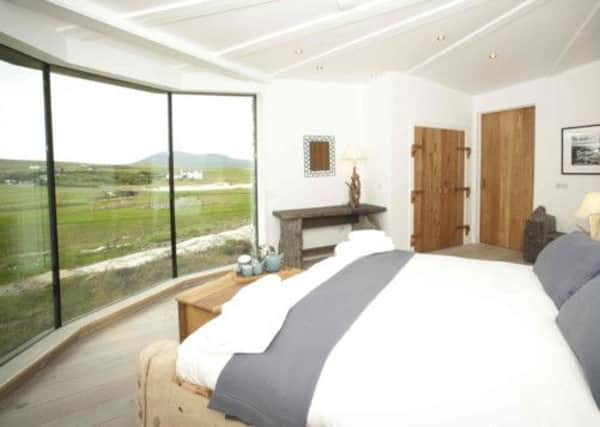Explosives created foundations of The Rock House in Harris


“Leverhulme became the UK’s largest landowner and was Lord of the Isles. Today, the estate has probably one of the most pristine coastlines left in Europe. The combination of mountains and ocean is unique, but essentially it’s a coastal estate with a focus on salmon fishing and now, tourism.”
Cathra’s father, Dr David Horrobin, a scientist and entrepreneur, purchased the estate in 1985 and carried out substantial renovations to the land and the properties before his death in 2003. Having spent so much time on the island with her father, Cathra has strong connections to Harris, as does her husband Adam. While a New Zealander by birth, Adam already had a pharmaceutical production business in nearby Callanish before the couple purchased the estate from the family trust in 2007.
Advertisement
Hide AdAdvertisement
Hide AdThe couple’s aim was to make Harris more accessible. “We wanted to invite people to enjoy Harris the way we do, but there was a shortage of high-end accommodation on the island,” says Adam. “Although it’s busier during the summer, people do visit all year round and would probably visit more if there were places to stay. Cathra and I didn’t sit down and make a plan, we just kept on talking and an idea evolved for self-catering properties. Before we knew it, planning applications had been approved and we were off.”
However, this project was more than just a couple of A-frame chalets. “We knew we had an extraordinary location and we wanted to do something special with the accommodation that would reflect the uniqueness of Harris. We had heard of Stuart Bagshaw, a very innovative architect based in Stornoway, and we asked him to come on board. We were drawn to his vernacular designs which utilised stone, lots of glazing and turf roofs. However, we also wanted to really unleash his style and push it a bit further. It was an ongoing dialogue between us and we wouldn’t have got here without Stuart,” says Adam.
Stuart’s role was to design two properties – The Broch and The Rock House – which would serve as luxurious, self-catering properties which minimised their impact on the environment and complemented the contrasting, natural beauty of Harris. The project took two years, but the end result is stunning.
“The inspiration for The Rock House was its location, which is a natural rock garden,” Kelliher recalls. “We wanted to build something that nestled within that rock garden, but I also wanted it to mirror the standing stones that you find throughout the Hebrides – a house built between standing stones.” This was easier said than done, for while the Kellihers were aware of the gneiss rock that is found throughout the Hebrides, they didn’t reckon on it being a problem when digging their foundations. “Gneiss rock is one of the oldest [three billion years] and hardest [three times harder than granite] and of course, we couldn’t dig through it. In the end we had to resort to dynamite. Basically the foundations became our quarry and the rocks that we dredged from the ground were used for all the small stone rock work in the dry-stone walling,” says Adam.
The monolithic rocks that give the property its standing stone effect were also on the estate and carefully lifted into place – pushing the local crane to its limits. “One of these is 9.5 tons. We built the property around it.”
On the roof, heather from the surrounding area has been laid on the turf, ensuring that both properties marry into the landscape and frameless glass allows uninterrupted views of the coastline and its environs.
Internally, the neutral backdrop is the perfect complement to the array of natural materials used as features. An old wooden boat mounted on the wall is a talking point in the living area, but it also hides the light fittings. Driftwood has been used for table legs and lamp bases and oversized pieces of slate serve as functional but contemporary shelving and a quirky, undulating, kitchen splashback.
“There are no straight lines in these buildings, everything has been hand built or moved into place such as the huge hearthstone. It’s a piece of gneiss we found on the shoreline and dragged up. It gives the impression we built the house around it,” says Kelliher. “Everything is bespoke, which of course took time, but then, I think the quality of the build speaks for itself. Logistically, this sort of project in the Hebrides is quite challenging, but the local craftsmen were first class.
Advertisement
Hide AdAdvertisement
Hide Ad“The main contractor was Lewis Builders from Stornoway and the external contractors were stonemasons. My mentality was to let them run amok. Within our general guidance of course! But we wanted them to let their creativity flow and it was quite amusing how this evolved. We had to change stonemasons – whilst the first one had done a beautiful job, it was spick and span and orderly, but that’s not what we wanted. When the second stonemason started we stipulated it had to be random, as random as nature itself. We wanted to keep it raw and very elemental, which is what Harris is like.”
Raw, elemental, but sheltered from the elements and full of the requisite mod cons, both The Broch and The Rock House have lived up to Kelliher’s expectations – but he’s not quite finished yet. “We do have other possible locations and whilst it’s been challenging, we’ve had fun along the way. When we get so busy we have to start turning away guests, we’ll think about building the next one….”
• A week’s self-catering in The Rock House ranges from £850 to £1,350. Tel: 01859 550358 or visit www.borvelodge.com for further information.